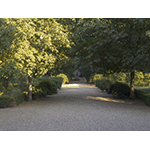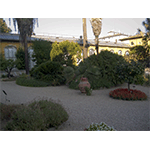Museo di Storia Naturale di Firenze - Orto Botanico "Giardino dei Semplici" [Museum of Natural History of Florence - "Giardino dei Semplici" (medicinal herb garden)]
arden)
The Botanical Garden of Florence, known as the "Giardino dei Semplici", was born as a garden of medicinal plants, and completed on December 1, 1545, under Cosimo I de’ Medici. It is the third oldest in the world. About two years before, Cosimo had founded the Botanical Garden of Pisa, the first example of a university Botanical Garden. The works for the two gardens were directed by famed botanist from Imola, Luca Ghini. The Garden experienced a period of great splendour towards the end of the century under the direction of Giuseppe Casabona who enriched it with many rare plants. In the course of the 17th century, the activity of Paolo Boccone and other botanists and gardeners, gave the Garden a certain autonomy, despite the fact that the Botanical Gardens of Santa Maria Nuova and of Pisa performed a scientific role of greater importance. The Florentine Garden’s heyday began in 1718 when, by order of Cosimo III, its direction was entrusted to Pier Antonio Micheli, founder of mycology (the study of mushrooms) and describer of numerous botanical species, and to the cares of the Societą Botanica Fiorentina [Florentine Botanical Society], the first European botanical academy, instituted in 1716. In these years, the Garden increased its collections, enriching it with plants – not only medicinal – and making it world famous. It showed an imprint of modernity, beginning to diversify the study of botany from that of medicine, disciplines then closely tied to one another. At Micheli’s death in 1737, he was replaced by Giovanni Targioni Tozzetti and then, by Saverio Manetti who, in 1746, had the great merit of being the first to publish an index of seeds (Index seminum) from the plants in the Garden, with the main purpose of promoting exchange with other Italian and foreign botanical gardens. Following the union of the Florentine Botanical Society and the Accademia dei Georgofili in 1783, the Garden passed under the Accademia, considerably changing its internal structure, which was simplified and rationalised to make room for cultivations of farm and fruit plants. In 1880, under the direction of Teodoro Caruel, several large greenhouses were built, which are still in use today. The Garden had by then become an institution of such great cultural importance that in 1905, the plan to join the Botanical Institute founded by Filippo Parlatore and housed in the Museum of via Romana, to the Herb Garden was carried out. During the past century, the Garden, along with the city of Florence, experienced moments of splendour alternated with tragic periods and episodes, such as war, though constantly increasing its scientific imprint and reaffirming its importance on the Florentine and Italian cultural panorama.
The hot greenhouses, among the largest in Italy, house several tropical plants that have been used since time immemorial, and from which medicinal and food products are extracted, such as coffee, cocoa, cotton, pepper.
Once at the central fountain, your back to the Garden entrance, on the far left you see a marble niche with an eighteenth-century bust portraying Asclepius, the Greek demigod, protector of the medical arts. On the right of the bust of Asclepius, stands the oldest plant in the Garden, the yew-tree (Taxus baccata), an extremely poisonous conifer planted in 1720 by Pier Antonio Micheli. The splendid male specimen of Yew is recorded in the list of monumental trees of the Commune of Florence.
In recent years, the Garden has begun to set up thematic exhibitions: in 2002, on the plants of the Tuscan medicinal tradition and orchids; in 2003, on botany in painting.
****************************
Texts by Graziano Magrini
English translation by Victor Beard
Last update 26/mar/2008





